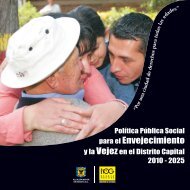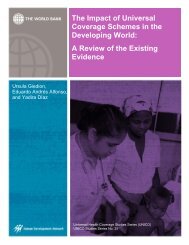11ZAQGM
11ZAQGM
11ZAQGM
You also want an ePaper? Increase the reach of your titles
YUMPU automatically turns print PDFs into web optimized ePapers that Google loves.
Impacts<br />
BIODIVERSITY IMPACTCS<br />
CHIEHA conservation and sustainable use activities have concentrated<br />
on the Zivambava Island Forest and Chibememe Mainland Forest, a<br />
combination of diverse riverine and savanna vegetation ecosystems.<br />
In Zivambava Island Forest alone, CHIEHA has been responsible for<br />
a doubling of the forest cover, with more than 200 hectares now<br />
protected. A further 120 hectares of forest surrounding Chibememe<br />
village have been conserved and used sustainably by the local<br />
population. The area is used for livestock rearing and the collection<br />
of non-timber forest products. The forests contain a high density<br />
of unique grass, trees, shrub and aloe species; several threatened<br />
animal species, including monkeys, pythons (three breeding sites<br />
with more than twelve snakes per site have been identified by<br />
community members), and elephants; a diverse assortment of bird<br />
species, including doves, honeycobs, qualias, eagles, and parrots; and<br />
populations of smaller mammals such as porcupines and anti bears.<br />
Human-wildlife conflict has been a priority for CHIEHA, as the<br />
farmers of Chibememe village and the Sangwe communal land<br />
come into regular contact with monkeys, wild pigs and elephants<br />
which can cause significant damage to agricultural projects and<br />
crop lands. Small game come from local forests and wood lots, while<br />
bigger game (e.g. elephants) comes from adjacent conservancies,<br />
national parks and private farms. CHIEHA has worked with the local<br />
population to employ a number of traditional land management<br />
techniques to mitigate human-wildlife conflict, notably growing<br />
crops on the boundaries of farms and fields that include sorghum,<br />
rapoko and cotton, which tend to repel these animals, and which<br />
serve as a natural buffer to facilitate co-habitation.<br />
CHIEHA does monitoring and evaluation of wildlife populations<br />
and natural resources through a participatory approach of local<br />
sampling. The group monitors the collection of firewood, timber,<br />
wild fruit and river sand, using community reporting. The same<br />
approach is employed for monitoring forest and grass cover and<br />
wildlife populations. Community members undertake sample<br />
counts, with a standard template which indicated the abundance,<br />
stability and depletion of known species in the area. Field guides<br />
monitor a range of species and combine this with feedback from<br />
the community – a combination of personal patrols and community<br />
reports. For larger game and wildlife, community monitors check for<br />
footprints and record different sounds.<br />
Additionally, CHIEHA is currently in the process of negotiating the<br />
possible co-management of a 10,000-hectare local wildlife area.<br />
There are positive signs that a Wildlife Land Reform Policy offers a<br />
window of opportunity for CHIEHA to leverage the success of the<br />
GLTPCA network and achieve success in its bid.<br />
SOCIOECONOMIC IMPACTS<br />
CHIEHA has clearly defined socioeconomic goals which include:<br />
raising the standard of living of group members by expanding<br />
sustainable livelihood options; restoring and reclaiming lost culture<br />
and traditions of the Sangwe; enhancing the participation of women<br />
and youth in conservation efforts; and strengthening the capacity<br />
of Sangwe residents to manage natural resources. The primary<br />
project beneficiaries are communities in the South Eastern Lowveld<br />
of Zimbabwe. The project’s target population is more than 150,000<br />
people, 65 percent of whom are women, all of whom live in rural areas,<br />
and over 80 percent of whom live below the national poverty line.<br />
The axes of CHIEHA’s work in sustainable livelihoods are the Non-<br />
Timber Forest Products Processing Centre and the multipurpose<br />
CHIEHA Environmental and Cultural Information Centre. The former is<br />
still under development, but currently processes a modest number of<br />
agro-biodiversity products, including peanut butter, Kigelia Africanna<br />
juice, and essential oils. The CHIEHA Environmental and Cultural<br />
Information Centre is the locus of awareness raising, environment<br />
and sustainable development workshops and meetings, information<br />
37






